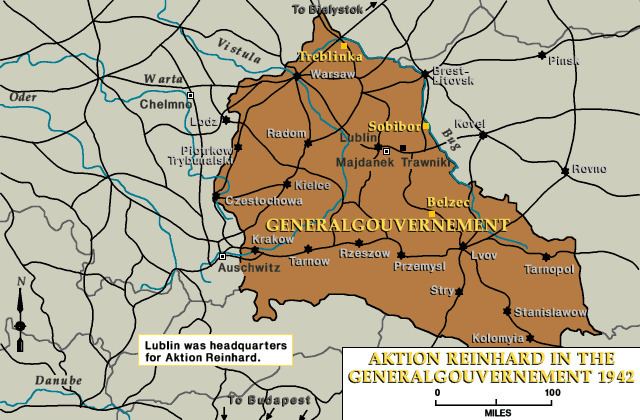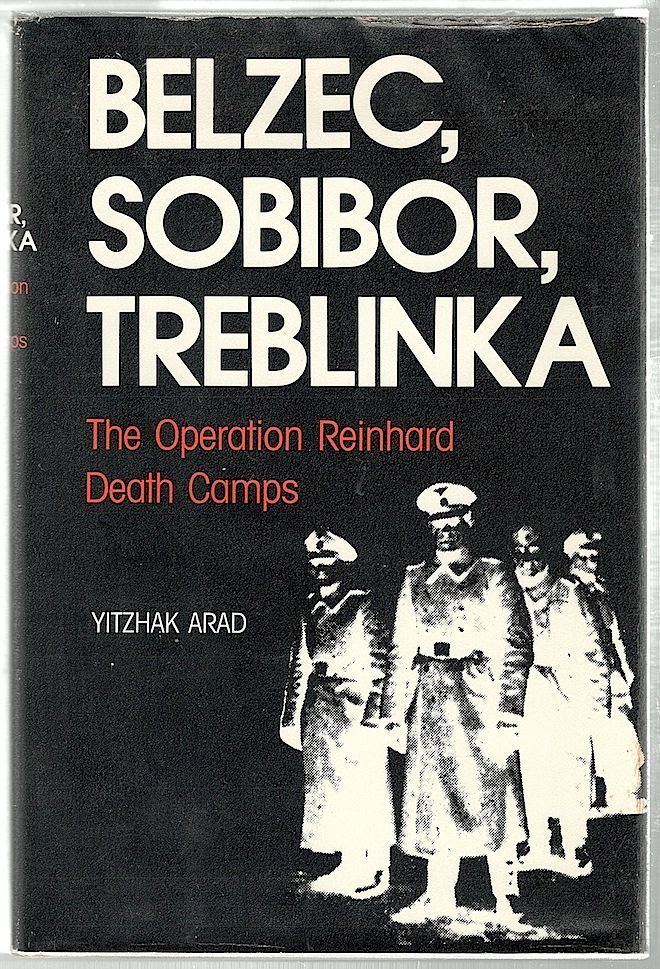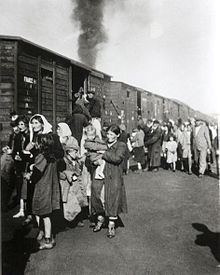Location Occupied Poland Start date July 1942 | Participants Nazi Germany | |
 | ||
Camp BełżecSobibórTreblinkaAdditional:ChełmnoMajdanekAuschwitz II Perpetrators Odilo Globocnik, Hermann Höfle, Richard Thomalla, Erwin Lambert, Christian Wirth, Heinrich Himmler, Franz Stangl | ||
Operation Reinhard or Operation Reinhardt (German: Aktion Reinhard or Aktion Reinhardt also Einsatz Reinhard or Einsatz Reinhardt) was the codename given to the secretive German Nazi plan to mass-murder most Polish Jews in the General Government district of German-occupied Poland, during World War II. The operation marked the deadliest phase of the Holocaust with the introduction of extermination camps.
Contents
- Background
- Operational name
- Death factories
- Extermination process
- Temporary substitution policy
- Disposition of the property of the victims
- Aftermath and cover up
- References

As many as two million Jews were sent to Bełżec, Sobibór, and Treblinka, extermination camps set up specifically for Operation Reinhard, to be put to death in gas chambers built for that purpose. In addition, mass killing facilities using Zyklon B were developed at about the same time within the Majdanek concentration camp, and at Auschwitz II-Birkenau near the existing Auschwitz I camp for Polish prisoners.

Background

The first concentration camps in Nazi Germany were established in 1933 as soon as the National Socialist regime developed. They were used for coercion, forced labour, and imprisonment, not for mass murder. The camp system expanded dramatically with the onset of the Second World War, in 1939. The new network of Nazi concentration camps built by SS in Germany, Austria, Poland, and elsewhere in Europe began exploiting foreign captives in war industry. The prisoners locked into forced labour began dying by the tens of thousands from starvation and untreated disease, or summary executions meant to inflict terror as at Soldau concentration camp, or Stutthof, with 40 sub-camps set up contingently for maximum profit. Some of the most notorious slave labour camps included Mauthausen, Dachau, Bergen-Belsen, Gross-Rosen (with 100 subcamps), Ravensbrück (70 subcamps), and Auschwitz (with 44 subcamps eventually), among other locations.

The Nazis had decided to undertake the European-wide Final Solution to the Jewish Question in January 1942 during a secret meeting of German leaders called by Obergruppenführer Reinhard Heydrich. The newly drafted Operation Reinhard would be a major step in the systematic liquidation of the Jews in occupied Europe, beginning with those in the General Government. Within months, three top-secret camps (at Bełżec, Sobibór, and Treblinka) were built solely to efficiently kill thousands of people each day. These camps differed from the likes of Auschwitz and Majdanek, because the latter operated as forced-labour camps initially, before they became death camps fitted with crematoria. Unlike "mixed" extermination camps, the extermination camps of Operation Reinhard took no prisoners and victims were killed on arrival. A very few survived by successfully escaping.

The organizational apparatus behind the new extermination plan had been put to the test already during the euthanasia Aktion T4 programme ending in August 1941, which resulted in the murders of more than 70,000 Polish and German disabled men, women, and children. The SS officers responsible for the Aktion T4, including Christian Wirth, Franz Stangl, and Irmfried Eberl, were all given key roles in the implementation of the "Final Solution" in 1942.
Operational name

The origin of the operation's name is debated by Holocaust researchers. Various German documents spell the name differently, some with "t" after "d" (as in "Aktion Reinhardt"), others without it. Yet a different spelling was used in the Höfle Telegram. It is generally believed that Aktion Reinhardt, outlined at Wannsee on 20 January 1942, was named after Reinhard Heydrich, the coordinator of the Endlösung der Judenfrage (the Final Solution of the Jewish Question) which entailed the extermination of the Jews living in the European countries occupied by the Third Reich. Heydrich was attacked by British-trained Czechoslovak agents on 27 May 1942 and died of his injuries eight days later. The earliest memo spelling out Einsatz Reinhard was relayed two months later.

In November 1946, Rudolf Höss, the former commandant of Auschwitz, suggested in a report while in Polish custody in Kraków, that Operation Reinhardt might have been named after the German State Secretary of Finance Fritz Reinhardt, who was in charge of the collection, sorting, and utilisation of personal belongings acquired from Jews killed at the extermination camps. However, Höss' theory cannot be proven by surviving documents. Heydrich himself had spelled his first name both Reinhard and Reinhardt throughout the 1930s according to Reichsführer-SS Heinrich Himmler. Meanwhile, Fritz Reinhardt and his ministry became involved with the operation well after it had received its name, according to historians Peter Witte and Stephen Tyas, thus confirming that the operation was indeed named after Reinhard Heydrich.
Death factories
On 13 October 1941, SS and Police Leader Odilo Globocnik headquartered in Lublin received an oral order from Heinrich Himmler – anticipating the fall of Moscow – to start immediate construction work on the first killing centre at Bełżec in the General Government territory of occupied Poland. Notably, the order preceded the Wannsee Conference by three months. The new camp was operational by March 1942, with leadership brought in from Germany under the guise of Organisation Todt (OT).
Globocnik was given complete control over the entire programme. All highly secretive orders he received came directly from Himmler and not from SS-Gruppenführer Richard Glücks, head of the greater Nazi concentration camp system run by the SS-Totenkopfverbände, and engaged in slave labour for the war effort. Each death camp was managed by between 20 and 35 officers from the Totenkopfverbände sworn to absolute secrecy, and augmented by the Aktion T4 personnel selected by Globocnik. The extermination program was designed by them based on prior experience from the forced euthanasia centres. The bulk of the actual labour at each "final solution" camp was performed by up to 100, mostly Ukrainian Trawniki guards, recruited by SS-Hauptsturmführer Karl Streibel from among the Soviet prisoners of war, and up to a thousand Sonderkommando prisoners whom they used to terrorise. The SS called their volunteer guards "Hiwis", an abbreviation of Hilfswillige (lit. "willing to help"). According to the testimony of SS-Oberführer Arpad Wigand during his 1981 war crimes trial in Hamburg, only 25 percent of recruited collaborators could speak German.
By mid-1942, two more death camps had been built on Polish lands: Sobibór (operational by May 1942) under the leadership of Hauptsturmführer Franz Stangl, and Treblinka (operational by July 1942) under SS-Obersturmführer Irmfried Eberl.
The killing mechanism consisted of a large internal-combustion engine pumping exhaust fumes into homicidal gas chambers through long pipes. Starting in February–March 1943 the bodies of the dead were exhumed and cremated in pits. Treblinka, the last camp to become operational, utilised knowledge learned by the SS previously. With two powerful V-8 petrol engines, run by SS-Scharführer Erich Fuchs, and gas chambers built of bricks and mortar, this death factory had killed between 800,000 and 1,200,000 people within 15 months, disposed of their bodies, and sorted their belongings for shipment to Germany.
The techniques used to deceive victims and the camps' overall layout were based on a pilot project of mobile killing conducted at the Chełmno extermination camp (Kulmhof), which began operating in late 1941 and used gas vans. Chełmno was not a part of Reinhard. It came under the direct control of SS-Standartenführer Ernst Damzog, commander of the SD in Reichsgau Wartheland. It was set up around a manor house similar to Sonnenstein. The use of gas vans had been previously tried and tested in the extermination of Jews on the Russian Front by the Einsatzgruppen. Between early December 1941 and mid-April 1943, 160,000 Jews were sent to Chełmno from the General Government via the Ghetto in Łódź. Chełmno did not have crematoria; only the mass graves in the woods. It was a testing ground for the establishment of faster methods of killing and incinerating people, marked by the construction of stationary facilities for the mass murder. The Reinhard death factories adapted progressively as each new site was built.
Taken as a whole, Globocnik's camps at Bełżec, Sobibór, and Treblinka had almost identical design, including staff members transferring between locations. The camps were situated within wooded areas well away from population centres. All were constructed near branch lines that linked to the Polish railway system; and each had an unloading ramp at a fake railway station, as well as a reception area that contained undressing barracks, barber shops, and money depositories. Beyond the receiving zone, at each camp was a narrow, camouflaged path (the so-called Himmelfahrtsstraße, the Road to Heaven, or der Schlauch known by the SS) that led to the extermination zone consisting of gas chambers, and the burial pits, up to 10 metres (33 ft) deep. Later, cremation pyres were introduced with rails laid across the pits on concrete blocks; refuelled continuously by the Totenjuden. Both Treblinka and Bełżec were equipped with powerful crawler excavators from Polish construction sites in the vicinity, capable of most digging tasks without disrupting surfaces. At each camp, the SS guards and Ukrainian Trawnikis lived in a separate area from the Jewish work units. Wooden watchtowers and barbed-wire fences camouflaged with pine branches surrounded all camps.
The killing centres had no electric fences, as the size of prisoner Sonderkommandos (work units) remained relatively easy to control, unlike in camps such as Dachau and Auschwitz. To assist with the arriving transports only specialised squads were kept alive, removing and disposing of bodies, and sorting property and valuables from the dead victims. The Totenjuden forced to work inside death zones were kept in isolation from those who worked in the reception and sorting area. Periodically, those who worked in the death zones would be killed and replaced with new arrivals to remove any potential witnesses to the scale of the mass murder.
During Operation Reinhard, Globocnik oversaw the systematic killing of more than 2,000,000 Jews from Poland, Czechoslovakia, France, the Reich (Germany and Austria), the Netherlands, Greece, Hungary, Italy and the Soviet Union. An undetermined number of Roma were also killed in these death camps, many of them children.
Extermination process
In order to achieve their purposes, all death camps used subterfuge and misdirection to conceal the truth and trick their victims into cooperating. This element had been developed in Aktion T4, when disabled and handicapped people were taken away for "special treatment" by the SS from "Gekrat" wearing white laboratory coats, thus giving the process an air of medical authenticity. After supposedly being assessed, the unsuspecting T4 patients were transported to killing centres. The same euphemism "special treatment" (Sonderbehandlung) was used in the Holocaust.
The SS used a variety of ruses to move thousands of new arrivals travelling in Holocaust trains to the disguised killing sites without unleashing panic. Mass deportations were called "resettlement actions"; they were organised by special Commissioners, and conducted by uniformed police battalions from Orpo and Schupo in an atmosphere of terror. Usually, the deception was absolute. For example, in August 1942, people of the Warsaw Ghetto lined up for several days to be "deported" in order to obtain bread allocated for travel. Jews unable to move or attempting to flee were shot on the spot. Even though death in the cattle cars from suffocation and thirst was rampant, affecting up to 20 percent of trainloads, most victims were willing to believe that the German intentions were different. Once alighted, the prisoners were ordered to leave their luggage behind and march directly to the "cleaning area" where they were asked to hand over their valuables for "safekeeping". Common tricks included the presence of a railway station with awaiting "medical personnel" and signs directing people to disinfection facilities. Treblinka also had a booking office with boards naming the connections for other camps further East.
The Jews most apprehensive of danger were brutally beaten in order to speed up the process. At times, the new arrivals who had suitable skills were selected to join the Sonderkommando. Once in the changing area, the men and boys were separated from the women and children, and everyone was ordered to disrobe for a communal bath: "quickly – they were told – or the water will get cold." The old and sick, or slow, prisoners were taken to a fake infirmary named the Lazarett, that had a large mass grave behind it. They were killed by a bullet in the neck, while the rest were being forced into the gas chambers.
To drive the naked people into the execution barracks housing the gas chambers, the guards used whips, clubs, and rifle butts. Panic was instrumental in filling the gas chambers, because the need to evade blows on their naked bodies forced the victims rapidly forward. Once packed tightly inside (to minimize available air), the steel air-tight doors with portholes were closed. The doors, according to Treblinka Museum research, originated from the Soviet military bunkers around Białystok. Although other methods of extermination, such as the cyanic poison Zyklon B, were already being used at other Nazi killing centres such as Auschwitz, the Aktion Reinhard camps used lethal exhaust gases from captured Soviet tank engines. Fumes would be discharged directly into the gas chambers for a given period, then the engines would be switched off. SS guards would determine when to reopen the gas doors based on how long it took for the screaming to stop from within (usually 25 to 30 minutes). Special teams of camp inmates (Sonderkommando) would then remove the corpses on flatbed carts. Before the corpses were thrown into grave pits, gold teeth were removed from mouths, and orifices were searched for jewellery, currency, and other valuables. All acquired goods were managed by the Main SS Economic and Administrative Department.
During the early phases of Operation Reinhard, victims were simply thrown into mass graves and covered with lime. However, from 1943 onwards, to hide the evidence of this war crime, all bodies were burned in open air pits. Special Leichenkommando (corpse units) had to exhume bodies from the mass graves around these death camps for incineration.
Nevertheless, Reinhard still left a paper trail. In January 1943, Bletchley Park intercepted an SS telegram by Sturmbannführer Hermann Höfle, Globocnik's deputy in Lublin, to Obersturmbannführer Adolf Eichmann in Berlin. The decoded Enigma message contained statistics showing a total of 1,274,166 arrivals at the four Aktion Reinhard camps until the end of 1942, but the British code-breakers did not understand the meaning of the message, which amounted to material evidence of how many people the Germans themselves confirmed they had murdered.
Temporary substitution policy
In the winter of 1941, before the Wannsee Conference but after the commencement of Operation Barbarossa, the Nazi demands for forced labor greatly intensified. Therefore, Himmler and Heydrich approved the Jewish substitution policy in Upper Silesia and in Galicia under the "destruction through labor" doctrine. The masses of ethnic Poles had already been sent to the Reich, creating a labour shortage in the General Government. Around March 1942, while the first extermination camp (Bełżec) only began gassing, the deportation trains arriving in the Lublin reservation from the Third Reich and Slovakia were searched for the Jewish skilled workers. After selection, they were delivered to Majdan Tatarski instead of for "special treatment" at Bełżec. For a short time these Jewish laborers were temporarily spared death, while their families and all others perished. Some were relegated to work at a nearby airplane factory or as forced labor in the SS-controlled Strafkompanies and other work camps. Hermann Höfle was one of the chief supporters and implementers of this policy.
However, the problems were the food they required and the ensuing logistical challenges. Globocnik and Friedrich-Wilhelm Krüger complained, and the mass transfer had stopped even before the three extermination camps were working at full throttle.
Disposition of the property of the victims
Approximately 178 million German Reichsmarks worth of Jewish property (current approximate value: around US$700 million or 550 million Euro) was taken from the victims, with vast transfers of gold and valuables to the Reichsbank's "Melmer" account, Gold Pool, and monetary reserve. But this wealth did not only go to the German authorities, because corruption was rife within the death camps. Many of the individual SS members and policemen involved in the killings took cash, property, and valuables for themselves. SS-Sturmbannführer Georg Konrad Morgen, an SS judge from the SS Courts Office, prosecuted so many Nazi officers for individual violations that by April 1944, Himmler personally ordered him to restrain his cases.
Aftermath and cover up
Operation Reinhard ended in November 1943. Most of the staff and guards were then sent to northern Italy for further Aktion against Jews and local partisans. Globocnik went to the San Sabba concentration camp, where he supervised the detention, torture, and killing of political prisoners.
At the same time, to cover up the mass murder of more than two million people in Poland during Operation Reinhard, the Nazis implemented the secret Sonderaktion 1005, also called Aktion 1005 or Enterdungsaktion ("exhumation action"). The operation, which began in 1942 and continued until the end of 1943, was designed to remove all traces that mass murder had been carried out. Leichenkommando ("corpse units") comprising camp prisoners were created to exhume mass graves and cremate the buried bodies, using giant grills made from wood and railway tracks. Afterwards, bone fragments were ground up in special milling machines, and all remains were then re-buried in freshly dug pits. The Aktion was overseen by squads of the Trawniki guards.
After the war, some of the SS officers and guards were tried and sentenced at the Nuremberg trials for their role in Operation Reinhard and Sonderaktion 1005; however, many others escaped conviction, such as Ernst Lerch, Globocnik's deputy and chief of his Main Office, whose case was dropped for lack of witness testimony.
